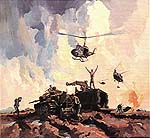1 Armoured Squadron Workshop, RAEME, South Vietnam
OC's Diary — January - June 1968
Index of Links
About the Author Preface Introduction January — 1 to 10 January — 11 to 20 January — 21 to 31 Tet 1968 February — 1 to 14 February — 15 to 29 March — 1 to 15 March — 16 to 31 April — 1 to 30 May — 1 to 31 June — 1 to 20 Abbreviations
Conclusion
During its time in theatre, the Armoured Squadron Workshop achieved its aim in keeping the Armd Sqn's equipment in battleworthy condition. This work was carried out with enthusiasm and total dedication, by both regular and National Servicemen. They all gave of their best and I was very proud of my association with them. Though some 20 years have passed, I still feel a sense of pride in the men under my command.
This diary is published for two reasons
- The first is to act as a reminder to all the men who served with the Unit — a record of their accomplishments and a memory jolter of times shared with comrades in a never–to–be–forgotten period in their lives.
- The second is for those students of military history who may gain some little knowledge from my experiences as a Workshop Commander and of the Unit's operations.
Theatres of war teach us many things — some are retained, some are not. History shows we are quite capable of making the same mistake twice!
I conclude my Diary with my thoughts on what could be learnt from the Vietnam theatre, relevant to an armoured squadron workshop, and useful as general principles in any Workshop/LAD operation.
- Forward Repair Teams (FRT)
- When planning FRT's it is easy to put in too many people to try to cover all trades.
- It must be remembered that the FRT has to be accommodated, fed, and have its own protection pits etc. This can create a problem for the Arms people.
- A small FRT which can, if necessary, cross over tradesmen; e.g., VM doing some GE work, Tels doing electrical work, could be easier to employ and control. It is appreciated that every situation is different, but in VIETNAM it was not difficult with helicopters, to insert specialist personnel for a specific job and then get them quickly back to base for workshop work.
- Signals
- In any theatre, keeping the signal lines open and maintaining security is critical. The Armd Sqn Workshop used a system of prepared parts sheets suitable for the equipment held, so an FRT signal could read "B Sheet 23 less items 2,5,7. Plus 1 pkt 8g Ferrodo Welding Rods."
- This can be passed quickly with minimum of security risk.
- No set procedure need be set down but it is necessary to realise the advantage of a simple system to suit the needs of that FRT.
- Defence
- RAEME has always trained its soldiers in defence procedures and in VIETNAM this was important.
- Wire laying, flares and mines were all part of security as were siting and digging weapon pits and mortar shelters. Target indication, and talking in artillery support are also skills our soldiers must have.
- Clearing patrols were a daily task in our areas of responsibility and the members of FRTs were subjected to direct contact with the enemy.
- RAEME soldiers must be well trained in all facets of defence, and the attitude of "I am a specialist and not an infantry soldier", must be rectified. For survival we must be infantry first.
- Training
- The Armd Sqn Workshop was formed but did not come together until we arrived in VIETNAM. Quite a few of the cfn, cpls, and sgts had no Armd vehicle experience, throwing a heavy training load on the experienced senior NCO's and WO's.
- I appreciate that all units must run internal training even in theatre, but it is essential that prior to arrival all tradesmen should be familiar with the equipment that will be the LAD responsibility. I understand that this cannot be achieved 100% but must be a RAEME Training aim.
- De-briefing
- It is unfortunate that people returning from a theatre of war are not debriefed. The information gathered could be useful in honing up procedures to produce a better LAD or workshop.
- Command and Control
- It is obvious when reading this Diary that there was not harmony, and unnecessary stress was created because of poor command policies. For example, the following incidents did occur without any consultation with the Workshop OC, 21C, or ASM.
- Fire fighting equipment and other stores were removed from the RAEME area for permanent use in the parent unit area.
- Tradesmen were ordered off their allocated tasks and re-employed by the parent unit.
- Forward Repair Teams and Recovery Teams were moved out on operations without consultation with OC Workshop.
- The RAEME OC was not included in some 0 Groups where his men were to participate in forthcoming operations. The RAEME OC was ordered not to prepare and submit Not Fair Wear Reports.
- It must be remembered that in an LAD, Workshop attached, or RAEME attached, the Parent Unit Commander has the power to assume total control, and neither the DADEME Task Force nor EME Task Force can interfere with the Parent Unit Commander's policies. The Parent Unit Commander can employ the RAEME people any way he sees fit. However, the Workshop, LAD and RAEME attached can and must process all technical reports and returns direct to EME Task Force and/or DADEME Task Force according to procedures relating to that theatre of operation.
- Personalities will always make it easy or hard and both the RAEME and Arms people need to understand personnel management to lessen conflicts.


